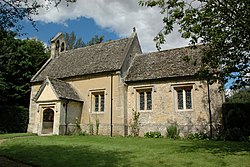Yelford
| Yelford | |
| Oxfordshire | |
|---|---|
 St Nicholas and St Swithun, Yelford | |
| Location | |
| Grid reference: | SP359047 |
| Location: | 51°44’20"N, 1°28’52"W |
| Data | |
| Post town: | Witney |
| Postcode: | OX29 |
| Dialling code: | 01993 |
| Local Government | |
| Council: | West Oxfordshire |
| Parliamentary constituency: |
Witney |
Yelford is a village in Oxfordshire. It is about three miles south of Witney. In 1931 the parish had a population of 17, and it has not been measured individually since.
Parish church
The small parish church, St Nicholas and St Swithun, may have been founded as a chapel by 1221, when Philip of Hastings was recorded as patron of the living. It was completely rebuilt in about 1500. It was restored at some time between 1869 and 1873, which may be when the bellcote was added.[1]
History
Romano-British pottery has been found in two locations north of the manor, but still within the parish. There is also an Anglo-Saxon burial ground between the Yelford-Hardwick road and Westfield farm.
In 1086 the Domesday Book records that Walter of Ponz held the manor of Yelford. Walter's other manors included Eaton Hastings, and together his manors were sometimes called the Honour of Hastings.
The Black Death scythed through the village in 1348–1349 and this has been evidenced by subsequent archaeological exploration. The Oxfordshire Museum has a large archive of pottery and other artifacts with the great bulk of it is early mediæval up to 1350. Then there is very little until 17th century slipware, which mainly came from round the manor. The Calender of State Papers has occasional snippets of information. One of these is relevant: a court case in which Hastings was sued for cutting down oaks in Boys Wood “for mending his manor house” in the third quarter of the 15th century. (There is no record of the outcome, but Boys Wood was part of the Yelford estate in 1947.)
By 1221 the overlord of the manor was one Philip of Hastings, and in 1651 The Hastings family sold the manor of Yelford to William Lenthall, the Speaker of the House of Commons who famously defied King Charles in the trouble which burst into the Civil War. The manor remained in the Lenthall family until 1949.[2]
Excavations under the hall floor in 1952 revealed pottery and bones that were dated to the 11th and 12th centuries, so the Saxon manor was probably on the same site as the current manor.
Yelford was always a small parish; in 1327, there were 16 taxpayers. By the 16th century were only 2 to 3 taxable households. By 1851 the population was only 17.[3]
In the latter part of the 15th century the Hastings family re-built the manor house as a timber-framed building with a moat.[4]
Outside links
| ("Wikimedia Commons" has material about Yelford) |
References
- ↑ Crossley et al. 1996, pp. 205-217.
- ↑ Crossley et al. 1996, pp. 205–217.
- ↑ A History of the County of Oxford - Volume 13 pp 205-208: (Victoria County History)
- ↑ Sherwood & Pevsner 1974, p. 869.
- A History of the County of Oxford - Volume 13 pp 205-208: Yelford: Introduction (Victoria County History)
- Nikolaus Pevsner: The Buildings of England: Oxfordshire, 1974 Penguin Books ISBN 978-0-300-09639-2page 869